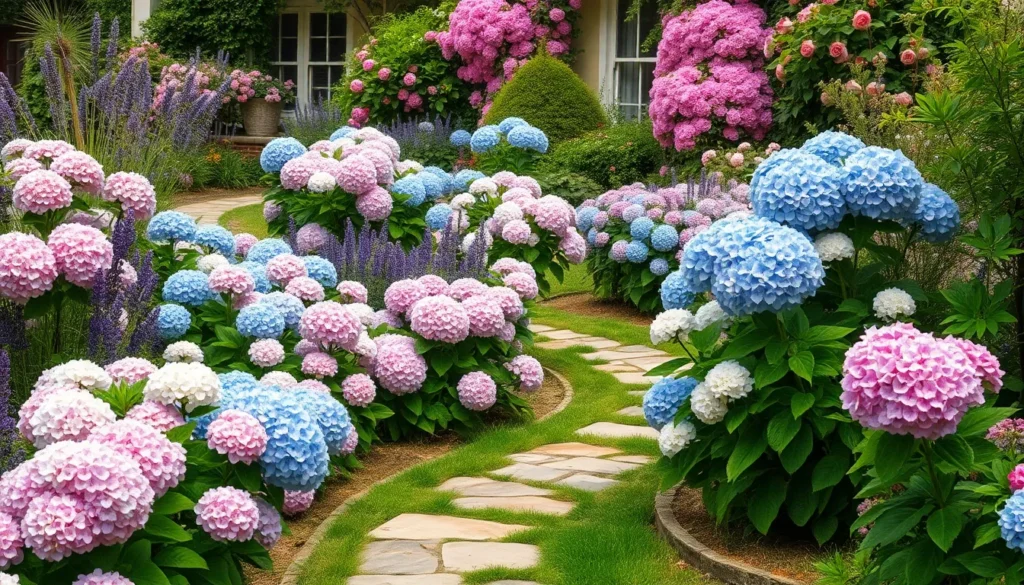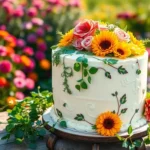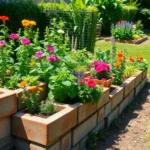Hydrangeas transform ordinary gardens into stunning outdoor sanctuaries with their spectacular blooms and versatile growing habits. We’ve discovered that these magnificent flowering shrubs offer endless possibilities for creating breathtaking industry designs that captivate visitors and boost your home’s curb appeal year after year.
Whether you’re working with a sprawling backyard or a compact urban space, hydrangeas adapt beautifully to various garden styles and conditions. From classic cottage gardens bursting with pastel blooms to modern minimalist designs featuring structured plantings, we’ll show you how to harness these showstopping flowers’ full potential.
Our comprehensive collection of hydrangea garden ideas will inspire you to create the outdoor oasis you’ve always dreamed of. We’ll explore creative planting combinations, strategic placement techniques, and design principles that maximize visual impact while ensuring your hydrangeas thrive for decades to come.
Create a Classic Cottage Garden With Mixed Hydrangea Varieties
We can transform our outdoor space into a charming English cottage garden by combining different hydrangea varieties with traditional plants and thoughtful design elements. This timeless approach creates layers of texture, color, and fragrance that bloom throughout the growing season.
Choose Complementary Bloom Colors
Selecting hydrangea varieties with complementary colors creates visual harmony in our cottage garden design. We recommend pairing soft pink Endless Summer hydrangeas with creamy white Annabelle varieties for a romantic palette that transitions beautifully through the seasons.
Blue and purple hydrangea combinations work exceptionally well in acidic soil conditions. Nikko Blue hydrangeas paired with purple Twist-n-Shout varieties create stunning contrast against green foliage backdrops.
Mixing warm and cool tones adds depth to our plantings. We can combine coral PeeGee hydrangeas with lavender Cityline varieties to achieve a sophisticated color scheme that complements traditional cottage garden roses.
White hydrangeas serve as excellent neutral anchors between bolder colors. Bobo dwarf hydrangeas and white Limelight varieties provide clean transitions that prevent color clashing in mixed borders.
Incorporate Traditional Cottage Plants
Traditional cottage plants enhance our hydrangea displays while maintaining authentic garden character. We suggest planting lavender, catmint, and salvia as companion plants that thrive in similar growing conditions as hydrangeas.
Climbing roses create vertical interest when planted near hydrangea shrubs. David Austin roses like Graham Thomas or Lady of Shalott provide repeat blooms that complement hydrangea flowering periods perfectly.
Perennial favorites such as delphiniums, foxgloves, and hollyhocks add cottage garden authenticity. These tall spikes create dramatic backdrops for mounded hydrangea shapes while attracting beneficial pollinators to our garden space.
Ground covering plants like sweet alyssum, creeping thyme, and lamium fill gaps between larger plantings. We can use these low growing options to create seamless transitions from hydrangea clusters to pathway edges.
Design Curved Pathways Through Plantings
Curved pathways create natural flow through our hydrangea cottage garden while showcasing different varieties from multiple viewing angles. We recommend using natural materials like flagstone, brick, or gravel that complement the informal cottage garden aesthetic.
Meandering paths allow us to position hydrangeas at strategic points where their blooms create focal points. Placing larger varieties like PeeGee hydrangeas at pathway curves draws the eye naturally through the garden space.
Varying pathway widths adds visual interest to our design layout. We can create wider areas near seating spots or particularly spectacular hydrangea displays while narrowing paths through more intimate garden sections.
Edging materials help define pathway boundaries without appearing too formal. Natural stone, weathered brick, or low growing plants like boxwood create gentle transitions between walkways and hydrangea plantings.
Design a Modern Minimalist Hydrangea Landscape
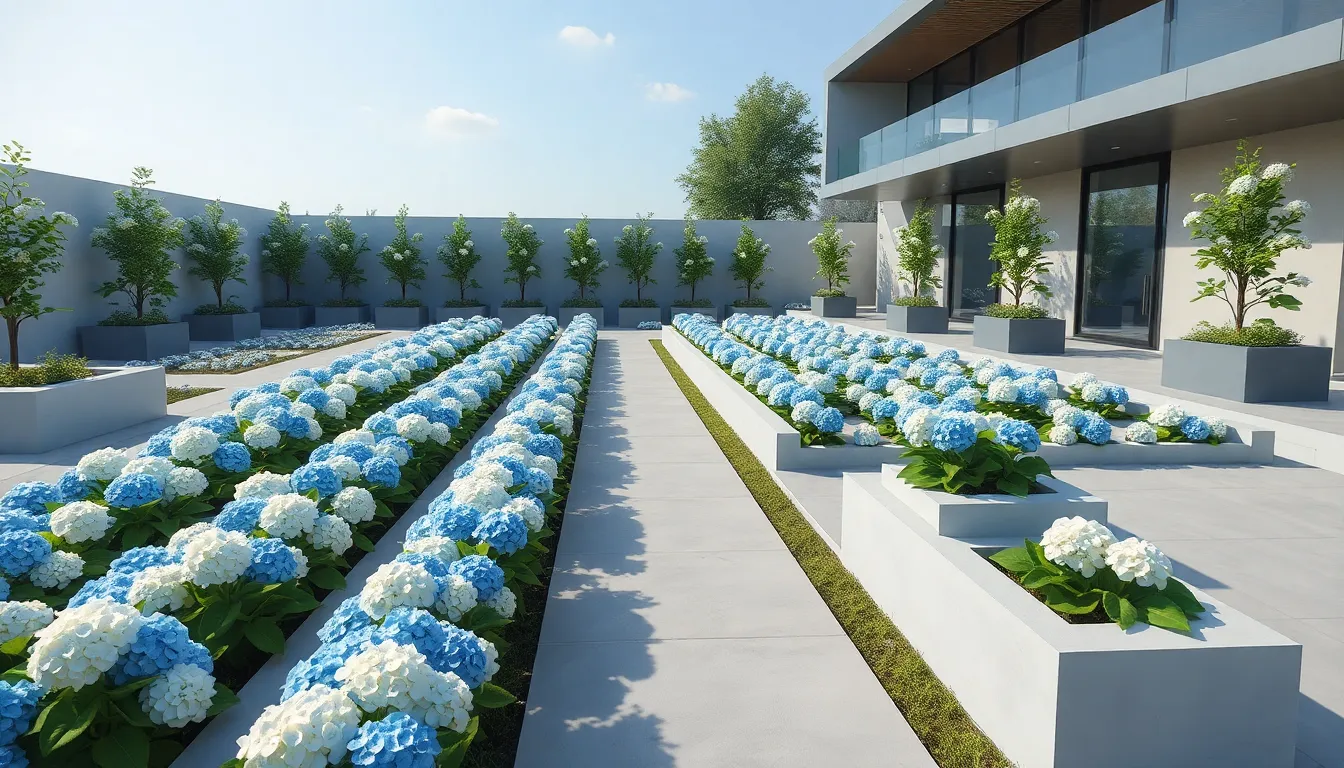
Moving from the romantic cottage garden approach, we’ll explore how hydrangeas can create stunning contemporary landscapes through strategic simplicity. Modern minimalist design transforms these beloved blooms into architectural elements that define outdoor spaces with sophisticated restraint.
Select Single-Color Hydrangea Schemes
Monochromatic displays create powerful visual impact in minimalist landscapes. We recommend choosing white varieties like ‘Limelight’ with their greenish white panicles or blue cultivars such as ‘Blue Danube’ for large showy blooms.
Soil pH control becomes your design tool for achieving consistent color schemes. Acidic soil conditions produce blue flowers while alkaline soil results in pink blooms, giving us precise control over our color palette.
Strategic variety selection enhances uniformity throughout the industry. Planting identical cultivars in grouped masses creates the clean repetition that defines minimalist aesthetics.
Use Clean Lines and Geometric Shapes
Grid patterns transform hydrangea plantings into structured industry elements. We arrange plants in precise rows or geometric configurations like triangular formations to enhance visual appeal.
Container gardening amplifies geometric design when we select modern planters with clean angular lines. These contemporary vessels complement the minimalist aesthetic while providing flexibility for seasonal arrangements.
Spacing consistency maintains visual rhythm across the industry. Equal distances between plants create the ordered appearance that defines modern garden design.
Add Contemporary Hardscaping Elements
Modern pergolas provide structural framework for climbing hydrangea varieties while maintaining clean architectural lines. These elements create vertical interest without compromising the minimalist approach.
Concrete and stone pathways guide movement through the hydrangea displays with purposeful direction. Clean lined walkways made from these materials enhance the contemporary feel while showcasing the plantings.
Sleek outdoor lighting highlights evening beauty of hydrangea blooms with strategic illumination. Modern fixtures complement the daytime minimalist design while extending garden enjoyment into nighttime hours.
Build Stunning Hydrangea Foundation Plantings
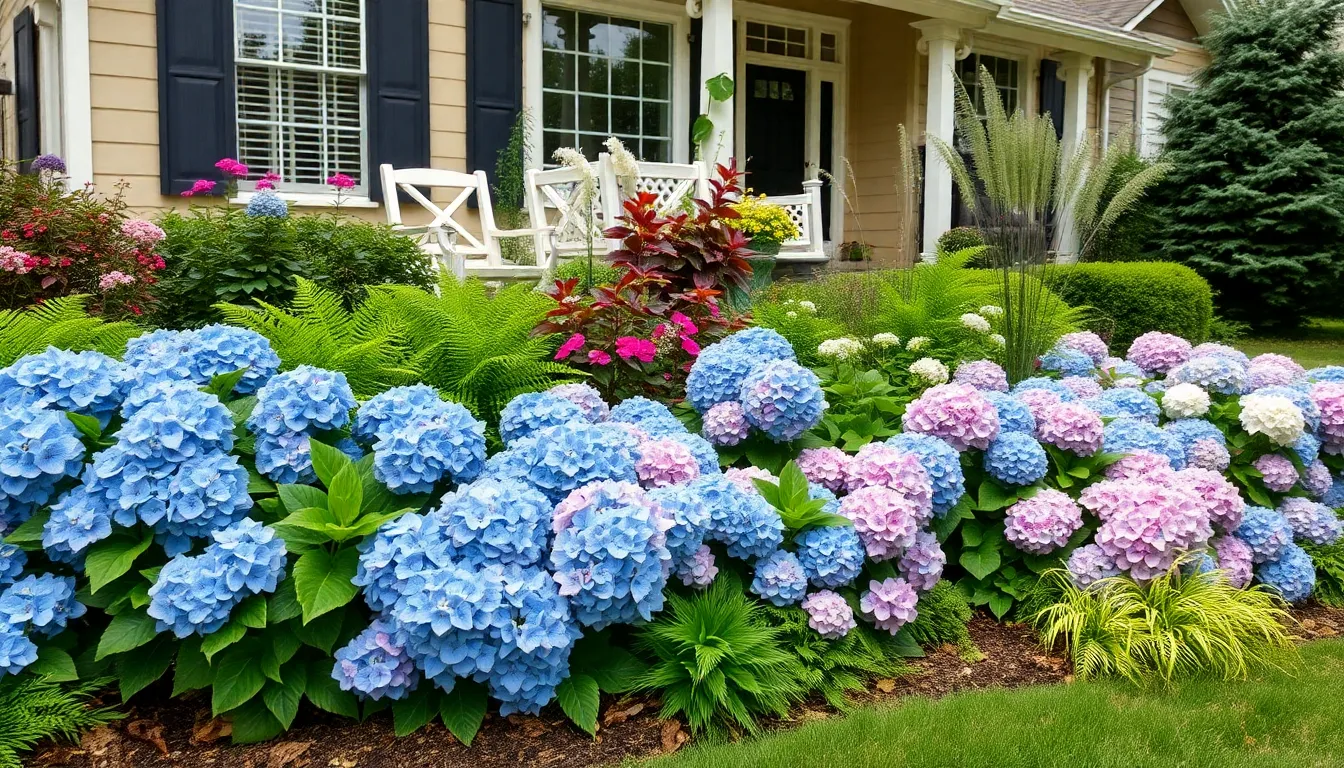
Foundation plantings transform the relationship between your home and garden, creating seamless transitions that enhance both architectural features and industry appeal. Hydrangeas excel in these strategic positions, offering the perfect combination of substantial foliage and spectacular blooms that soften building edges while providing year round visual interest.
Layer Different Heights and Textures
Combining hydrangeas with plants of differing heights creates depth and visual complexity that transforms flat foundation areas into ever-changing garden displays. We recommend positioning low growing perennials like Heuchera (coral bells) or Geranium (cranesbill) at the front edge, where their compact forms won’t obstruct sight lines to your hydrangeas. Medium sized shrubs work beautifully in the middle layer, providing transition space between ground level plants and your statement hydrangeas.
Tree form hydrangeas or small ornamental trees anchor the back layer, creating vertical interest that draws the eye upward and adds structure to your foundation design. This layered approach ensures something catches attention at every level, from delicate coral bells foliage near walkways to towering paniculata blooms that frame windows and entries. Strategic placement of varying textures throughout these layers adds year round appeal, with smooth hydrangea leaves contrasting beautifully against feathery ornamental grasses or bold hosta foliage.
Choose Varieties for Year-Round Interest
Selecting hydrangea cultivars with varying bloom times extends your foundation’s color season and maintains visual appeal from spring through fall. Early blooming bigleaf hydrangeas (Hydrangea macrophylla) provide spectacular June and July displays, while late blooming paniculata types like ‘Limelight’ continue the show into September and October. We suggest incorporating reblooming varieties such as Endless Summer series, which produce flowers on both old and new wood for extended color periods.
Winter interest becomes crucial for foundation plantings, where bare spots create unwelcome focal points near your home’s entrance. Choose hydrangeas with attractive bark features, such as climbing varieties with peeling cinnamon colored stems, or select cultivars with interesting seed heads that persist through winter months. Pairing these with evergreen companions ensures your foundation maintains structure and appeal even during dormant seasons.
Create Balanced Symmetrical Arrangements
Symmetry enhances curb appeal and creates polished, professional looking foundation displays that complement your home’s architectural style. Plant identical hydrangea specimens on either side of walkways, entries, or prominent windows, using odd numbers like three or five plants per grouping for the most natural and visually pleasing effect. Space plants according to their mature size, with compact Hydrangea macrophylla varieties requiring 4 to 6 feet between centers, while larger paniculata types need 6 to 8 feet for proper development.
Breaking up uniformity while maintaining balance requires careful selection of companion plants that complement rather than compete with your hydrangeas. Hostas and ferns work exceptionally well as alternating elements, their foliage textures providing contrast while their size keeps the overall composition harmonious. Regular pruning and shaping maintains your symmetrical arrangement’s crisp appearance, with annual trimming ensuring each plant develops the same general form and scale as its mirror image across the planting.
Establish a Shade Garden Paradise With Hydrangeas
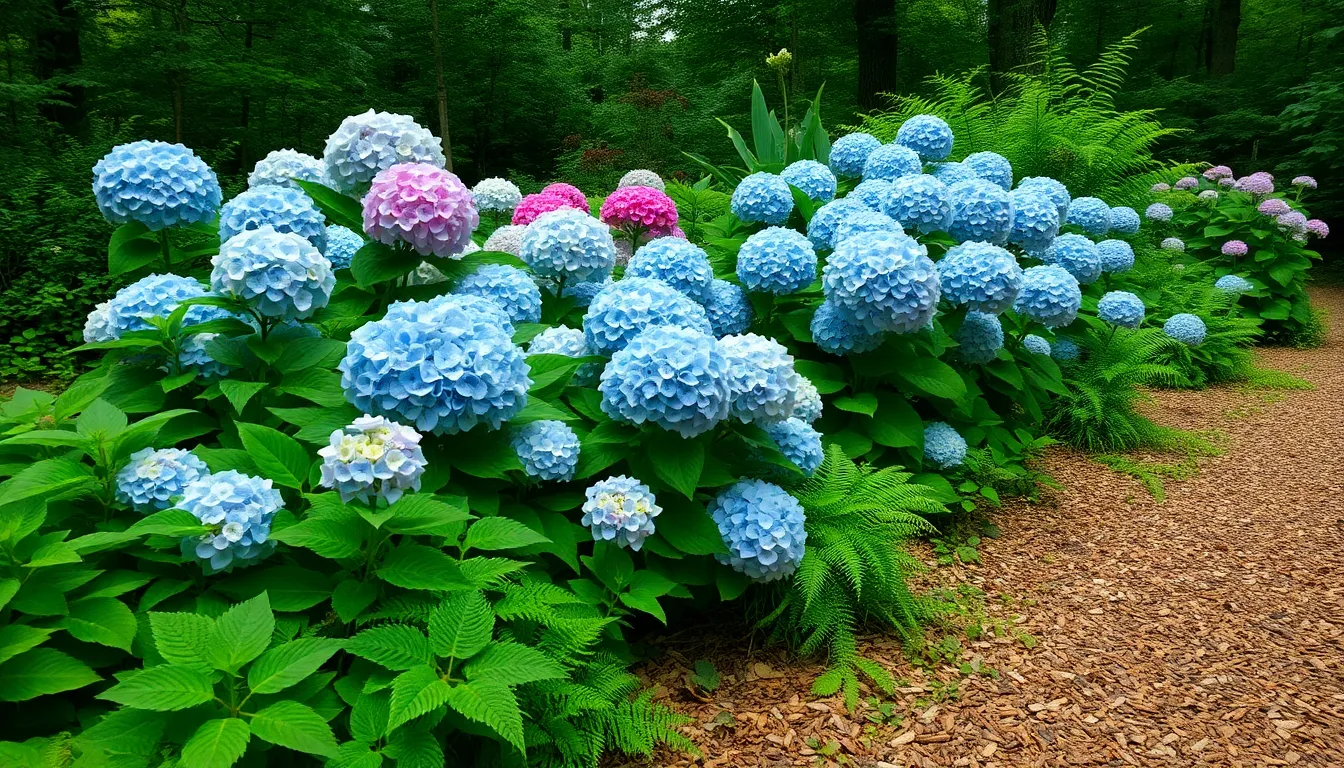
Creating a tranquil woodland retreat becomes effortless when we harness the natural beauty of shade-loving hydrangeas. These remarkable plants transform shaded areas into lush garden sanctuaries that offer year-round visual interest.
Select Shade-Tolerant Hydrangea Types
Bigleaf hydrangeas (Hydrangea macrophylla) thrive in partial shade conditions while producing spectacular flower displays in various colors. We recommend planting these versatile specimens in well-drained soil where they’ll receive morning sun and afternoon protection.
Oakleaf varieties (Hydrangea quercifolia) offer unique foliage textures that complement their white flower clusters perfectly. These hardy plants develop stunning fall color while tolerating deeper shade than most hydrangea species.
Mountain hydrangeas (Hydrangea serrata) provide delicate lacecap blooms that dance gracefully in filtered light. We’ve found these compact varieties work exceptionally well as understory plantings beneath established trees.
Each variety contributes distinct flower colors and foliage characteristics that create ever-changing visual layers throughout the growing season. Spacing these different types strategically allows us to maximize their individual strengths while creating cohesive garden compositions.
Combine With Hostas and Ferns
Hostas serve as perfect hydrangea companions with their broad, variegated leaves that provide striking textural contrast. We position large specimens like ‘Sum and Substance’ behind hydrangeas to create dramatic backdrops for colorful blooms.
Delicate ferns add feathery fronds that enhance the woodland atmosphere while softening harder plant edges. Royal ferns and Christmas ferns work particularly well alongside oakleaf hydrangeas because their fine textures complement the bold hydrangea foliage.
Coral bells (Heuchera spp.) introduce continuous color through purple, bronze, and chartreuse leaves that persist throughout the season. We plant these low-growing perennials at hydrangea bases to create seamless ground-level transitions.
Cranesbill geraniums (Geranium spp.) provide additional flowering interest with their delicate blooms and attractive foliage. These reliable perennials fill gaps between larger plantings while contributing extended seasonal color.
Layering these companions at different heights creates lush, multidimensional displays that showcase each plant’s unique characteristics. We arrange taller hostas and ferns as background elements while using shorter perennials as foreground accents.
Design Woodland Walking Paths
Natural mulch pathways guide visitors through hydrangea displays while maintaining the garden’s organic character. We create winding routes using bark chips or shredded leaves that complement the woodland aesthetic perfectly.
Stepping stone arrangements provide stable footing while allowing plants to spill naturally along path edges. These hardscape elements work best when we space them irregularly to mimic natural walking patterns through forest settings.
Native groundcover plantings like epimedium and wild ginger (Asarum) soften pathway borders while suppressing unwanted weeds. We establish these low-maintenance plants along path edges where they create seamless transitions between walkways and planted areas.
Strategic path placement maximizes viewing opportunities by positioning routes to showcase hydrangeas from multiple angles. We design curved pathways that reveal new garden vistas around each bend while encouraging slow, contemplative movement through the space.
Varying path widths creates visual interest while accommodating different garden activities. Wider sections accommodate seating areas where we can pause to appreciate the hydrangea displays, while narrower passages create intimate experiences among the plantings.
Construct Beautiful Hydrangea Border Gardens
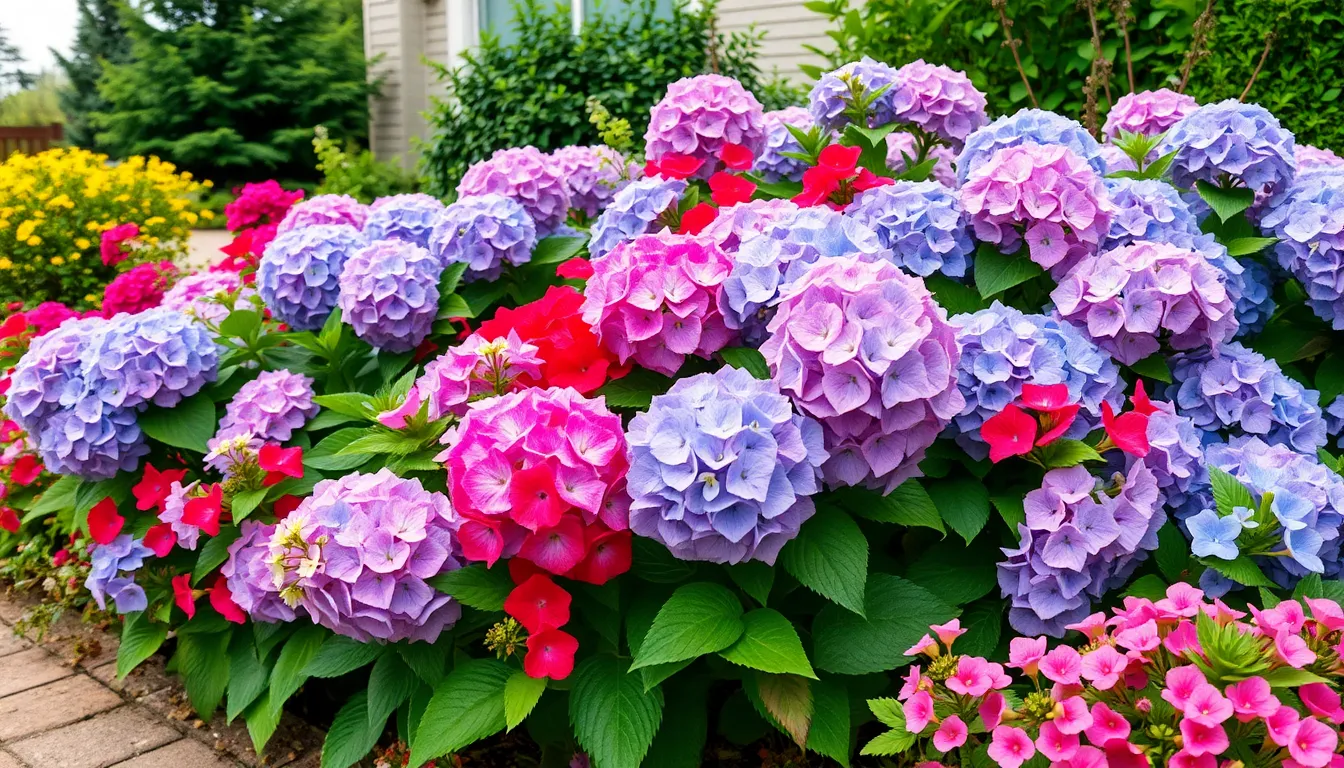
Building on our foundation and shade garden concepts, we can now explore how hydrangea borders create stunning focal points that frame your outdoor spaces. Selecting various hydrangea species and sizes allows us to create visually appealing landscapes that provide structure and seasonal interest.
Plan for Sequential Bloom Times
Timing becomes crucial when we design hydrangea borders that maintain visual appeal throughout the growing season. We achieve continuous color by pairing hydrangeas with perennials that bloom at different intervals.
Coral bells (Heuchera spp.) provide our gardens with reliable color from late spring to mid-summer, offering attractive foliage that complements hydrangea blooms perfectly. Their compact size makes them ideal for front border positions.
Cranesbill (Geranium spp.) extends our flowering season from spring to fall, creating cooling color combinations that enhance hydrangea displays. We position these perennials strategically to fill gaps between hydrangea bloom cycles.
Early spring bulbs like daffodils and tulips can kickstart our border season before hydrangeas emerge. Summer annuals such as impatiens or begonias maintain color during peak growing months.
Mix Hydrangeas With Perennial Companions
Combining hydrangeas with complementary perennials creates depth and texture in our border gardens. We select companions that enhance rather than compete with hydrangea blooms.
Coral bells offer year-round foliage interest with their burgundy, silver, or chartreuse leaves that contrast beautifully with hydrangea flowers. Their delicate flower spikes add vertical elements without overwhelming the display.
Cranesbill geraniums serve dual purposes in our hydrangea borders by providing cooling color palettes and natural weed suppression. Their sprawling habit fills spaces between larger hydrangea plants effectively.
Hostas work exceptionally well in partially shaded hydrangea borders, contributing bold foliage textures that highlight hydrangea blooms. We choose varieties with different leaf sizes and colors for maximum impact.
Astilbe adds feathery plumes that complement hydrangea’s rounded flower heads, creating textural contrast in our border designs. Their shade tolerance makes them perfect partners for woodland hydrangea varieties.
Create Natural Privacy Screens
Hydrangeas transform into effective privacy screens when we plant them in strategic rows or masses. Their dense foliage and substantial blooms block unwanted views while improving garden beauty.
We position larger hydrangea varieties like Paniculata types along property lines or around outdoor living spaces for maximum screening effect. These varieties reach 6-8 feet tall and maintain their structure throughout the growing season.
Poolside gardens benefit greatly from hydrangea privacy screens that create intimate spaces for relaxation. We select varieties that tolerate reflected heat and occasional splashing while providing lush backdrops.
Multiple hydrangea species planted in staggered heights create layered privacy screens that look natural rather than formal. We combine tall Paniculata varieties with medium-sized Bigleaf types for varied textures.
Regular spacing of 4-6 feet between plants allows proper air circulation while ensuring adequate coverage once plants mature. We supplement with evergreen shrubs for year-round privacy in colder climates.
Transform Slopes With Terraced Hydrangea Gardens
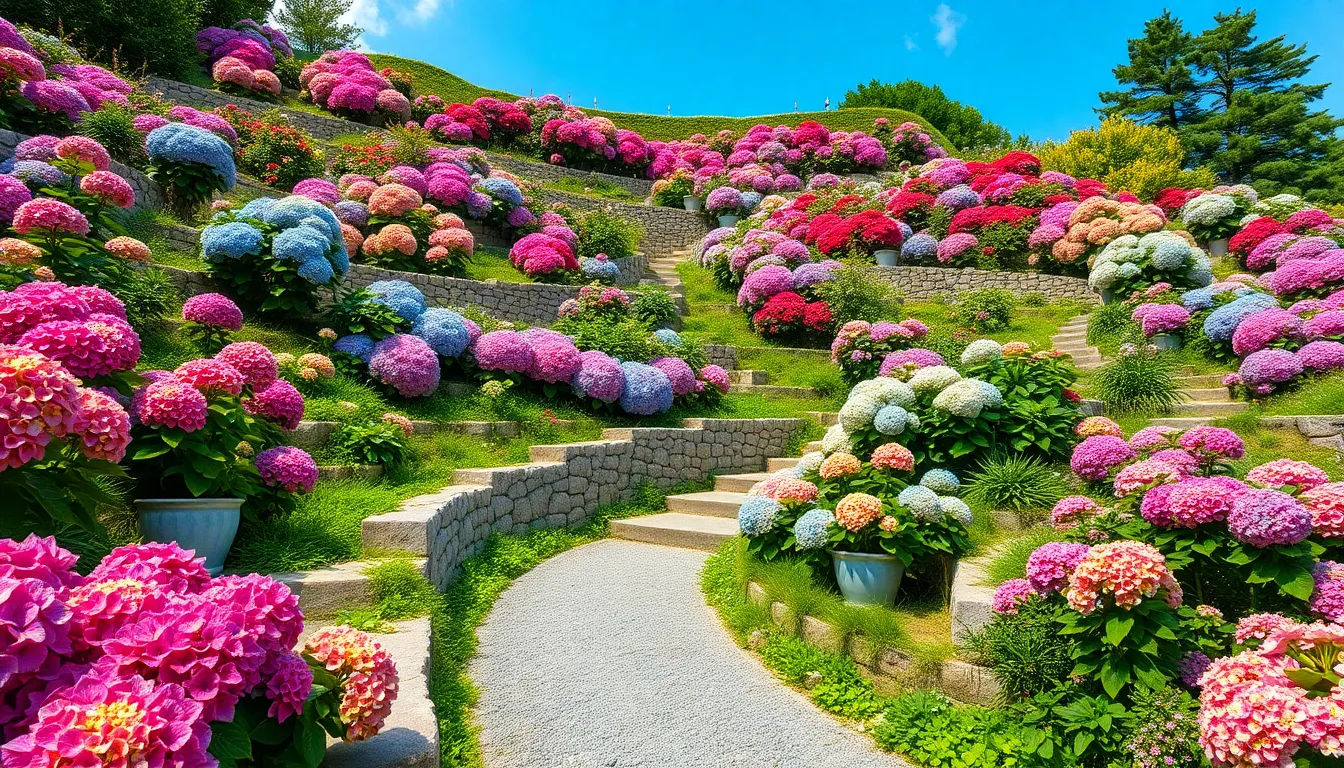
Steep slopes present unique opportunities to create dramatic garden displays. We’ll show you how to turn challenging terrain into stunning terraced hydrangea showcases.
Build Retaining Walls for Structure
Stone retaining walls create the foundation for successful terraced hydrangea gardens. We recommend building walls using natural stone or brick materials to establish distinct planting levels on your slope. These structures prevent soil erosion while adding architectural interest to your industry design.
Multi-level terraces offer enhanced planting opportunities for hydrangea displays. We suggest creating walls at varying heights to accommodate different hydrangea varieties and their mature sizes. Each terrace becomes a dedicated growing space that showcases your hydrangeas at eye level from different vantage points.
Proper drainage systems behind retaining walls ensure healthy hydrangea growth. We install gravel backfill and drainage pipes to prevent water buildup that could damage both walls and plant roots.
Choose Erosion-Control Varieties
Bigleaf Hydrangeas provide excellent soil stabilization with their robust root systems. We recommend these varieties specifically for slope plantings because their deep roots help anchor soil and prevent erosion. Their extensive root networks create natural barriers against soil movement during heavy rains.
Oakleaf Hydrangeas offer dual benefits of erosion control and seasonal interest. We plant these varieties on terraced slopes because they develop strong root systems while providing beautiful fall foliage colors. Their sturdy growth habit makes them ideal for steep terrain applications.
Strategic variety selection maximizes both beauty and soil protection. We combine different hydrangea types across terraces to create comprehensive root coverage while ensuring varied bloom times and colors throughout the growing season.
Design Multi-Level Visual Interest
Layered plantings create stunning visual depth across terraced hydrangea gardens. We arrange hydrangeas at different heights and complement them with low-growing plants like Coral Bells and Cranesbill to fill gaps and add texture. This approach ensures continuous color from ground level to the tallest terrace.
Pathways and steps connect terrace levels while improving garden accessibility. We incorporate stone or gravel walkways that wind between hydrangea plantings, creating viewing opportunities from multiple angles. These connections make maintenance easier while guiding visitors through the terraced display.
Bloom timing coordination extends the visual impact across all terrace levels. We select hydrangea varieties with staggered flowering periods to ensure at least one terrace shows peak blooms throughout the growing season. Early-blooming varieties on upper terraces can complement late-season flowers on lower levels.
Develop Container Hydrangea Display Gardens
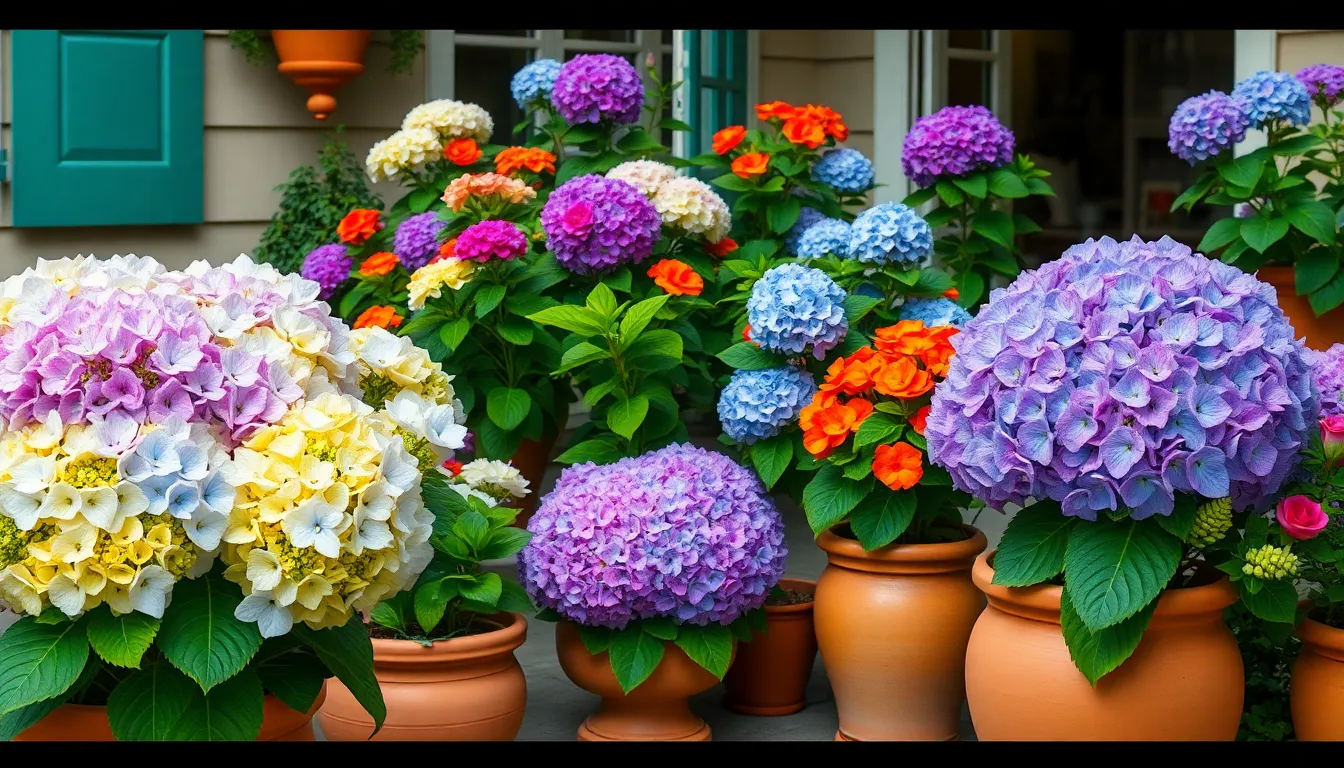
Container hydrangea gardens offer exceptional versatility for gardeners who want to enjoy these spectacular blooms without permanent industry commitments. We can transform any outdoor space into a stunning hydrangea showcase through strategic container placement and thoughtful design choices.
Select Appropriate Pot Sizes and Materials
Large containers measuring at least 24 inches in diameter provide the foundation for successful hydrangea container gardens. These spacious pots accommodate small to mid-sized hydrangeas for several years without requiring frequent transplantation, reducing maintenance while promoting healthy root development.
Quality potting soil delivers superior drainage compared to garden soil, preventing root rot and waterlogging issues that commonly plague container plants. We recommend lining the bottom of each pot with mesh or coffee filters to prevent soil loss through drainage holes while maintaining proper water flow.
Terracotta and ceramic materials excel at retaining moisture while allowing adequate drainage for hydrangea health. These pot materials regulate soil temperature more effectively than plastic alternatives, creating optimal growing conditions for our hydrangea displays.
Create Mobile Seasonal Arrangements
Containerized hydrangeas transform into flexible design elements that adapt to changing seasonal needs and aesthetic preferences. We can easily relocate these portable gardens to optimize their performance based on sunlight requirements, weather conditions, and visual impact throughout the year.
Seasonal arrangement updates become effortless when hydrangeas grow in containers rather than fixed industry positions. Moving arrangements allows us to feature blooming specimens prominently while repositioning dormant plants to less visible locations during off-peak periods.
Strategic mobility enables us to protect valuable hydrangea investments from harsh weather conditions by relocating containers to sheltered areas during extreme temperatures or storms.
Design Patio and Deck Installations
Patio integration opportunities multiply when we incorporate hydrangea containers as vibrant color and texture elements in outdoor living spaces. Corner placements create natural focal points while containers along railings establish beautiful boundaries without blocking sight lines.
Seating area enhancements emerge when we position hydrangea containers as living accent pieces that complement outdoor furniture arrangements. These strategic placements frame conversation areas while providing seasonal interest that changes throughout the growing season.
Deck installations benefit from hydrangea containers that add vertical dimension and natural beauty to typically flat surfaces. We can create layered displays using containers of varying heights to establish visual depth and architectural interest in otherwise monotonous deck landscapes.
Plan a Cutting Garden Focused on Hydrangeas
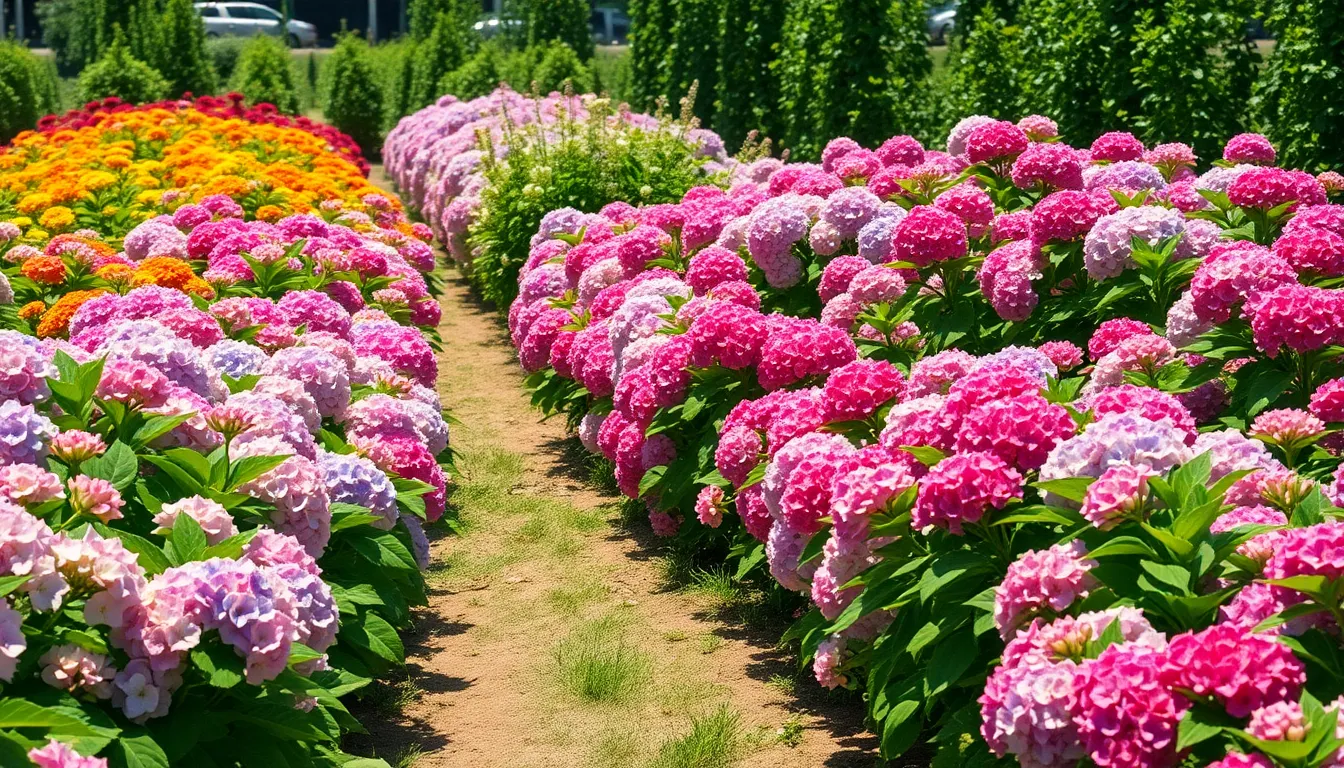
Creating a dedicated cutting garden allows us to enjoy hydrangeas’ stunning blooms indoors while maintaining our industry’s beauty. We’ll maximize our harvest potential through strategic variety selection and thoughtful garden design.
Choose Best Varieties for Fresh Arrangements
Bigleaf Hydrangea (Hydrangea macrophylla) produces the large, showy blooms that make exceptional centerpieces and arrangements. We recommend selecting these varieties for their superior cut flower performance and long-lasting beauty once harvested.
Panicle Hydrangea (Hydrangea paniculata) offers cone-shaped flower clusters that add dramatic height and texture to fresh bouquets. These varieties provide excellent structural elements for our arrangements while maintaining their form longer than other hydrangea types.
Mix bloom timing across our selected varieties to ensure continuous harvesting throughout the growing season. Early bloomers like certain Bigleaf varieties pair perfectly with mid-season Panicle types and late-flowering cultivars for extended cutting opportunities.
Semi-ripe cuttings taken in late summer help us propagate our favorite varieties without additional costs. This technique allows us to expand our cutting garden stock while preserving the exact characteristics we love most.
Design Dedicated Growing Rows
Row spacing of 3 to 6 feet between plants accommodates mature growth while providing easy access for maintenance and harvesting. We’ll adjust this distance based on each variety’s expected mature size to prevent overcrowding.
Companion planting with foliage shrubs and perennials adds texture and interest to our cutting garden design. These complementary plants provide additional cutting material while supporting our hydrangeas’ overall health and appearance.
Strategic layout positions taller Panicle varieties toward the back of rows with shorter Bigleaf types in front. This arrangement ensures optimal sunlight distribution while creating visual depth throughout our cutting garden space.
Create Proper Harvesting Access Points
Pathway width of at least 3 feet between growing rows accommodates gardening tools, harvest baskets, and comfortable movement during cutting sessions. We’ll maintain these pathways with mulch or gravel surfaces to prevent muddy conditions.
Access points at regular intervals along each row eliminate the need to reach across multiple plants during harvest time. Strategic placement of these entry points reduces plant damage while maximizing our efficiency during peak cutting seasons.
Maintenance considerations include well-drained pathway surfaces that remain stable in various weather conditions. Proper pathway design ensures we can access our hydrangeas for both harvesting and routine care throughout the growing season.
Conclusion
We’ve explored the incredible versatility of hydrangeas and how they can transform any outdoor space into a stunning garden paradise. From cottage-style plantings to modern minimalist designs these remarkable shrubs adapt beautifully to various garden styles and growing conditions.
Whether you’re working with challenging slopes shade-filled corners or sunny borders hydrangeas offer answers that combine beauty with practicality. Their ability to thrive in containers makes them perfect for renters and those who love flexible garden arrangements.
The key to hydrangea success lies in understanding your space and choosing varieties that match your vision. With proper planning and thoughtful companion plantings you’ll create a garden that provides year-round interest and endless cutting opportunities for indoor enjoyment.
Frequently Asked Questions
What are the best hydrangea varieties for cottage gardens?
For cottage gardens, consider pairing soft pink Endless Summer hydrangeas with creamy white Annabelle varieties. Mix warm and cool tones for visual depth. Traditional cottage plants like lavender and climbing roses complement hydrangea displays beautifully while maintaining the romantic, informal character that defines cottage garden style.
How can I create a modern minimalist garden with hydrangeas?
Use monochromatic displays with white varieties like ‘Limelight’ or blue cultivars such as ‘Blue Danube.’ Arrange plants in clean lines, grid patterns, or geometric shapes. Control soil pH to achieve consistent colors – acidic soil produces blue blooms, while alkaline soil creates pink flowers.
Which hydrangea varieties work best in shaded areas?
Bigleaf, Oakleaf, and Mountain hydrangeas thrive in low-light conditions. Combine them with shade-loving companions like hostas, ferns, and cranesbill geraniums. These varieties adapt well to woodland settings and create lush, multidimensional displays even in areas with limited sunlight.
How do I use hydrangeas for foundation plantings?
Layer different heights and textures by combining hydrangeas with low-growing perennials and medium-sized shrubs. Select varieties with varying bloom times for year-round interest. Use symmetrical arrangements with identical specimens for a polished look, and maintain balance through regular pruning.
What’s the best way to create privacy screens with hydrangeas?
Plant larger varieties like Paniculata in strategic rows or masses for maximum screening effect. Use staggered heights for a natural appearance, and combine with evergreen shrubs to ensure year-round privacy. Space plants appropriately to allow for mature growth while maintaining dense coverage.
How do I grow hydrangeas in containers?
Select large containers (at least 24 inches in diameter) for healthy root development. Use quality potting soil with superior drainage. Create mobile seasonal arrangements that can be relocated based on sunlight and weather conditions. This flexibility makes container hydrangeas perfect for patios and decks.
What should I know about creating a hydrangea cutting garden?
Choose varieties like Bigleaf and Panicle hydrangeas for exceptional cut flower performance. Mix bloom timings for continuous harvesting throughout the season. Design dedicated growing rows with proper spacing and create accessible harvesting points with maintained pathways for efficient cutting and garden care.
How can I prevent soil erosion with hydrangeas on slopes?
Select erosion-control varieties like Bigleaf and Oakleaf hydrangeas for their robust root systems that stabilize soil. Create terraced gardens using stone retaining walls for distinct planting levels. Incorporate layered plantings for visual depth while providing practical slope stabilization benefits.

